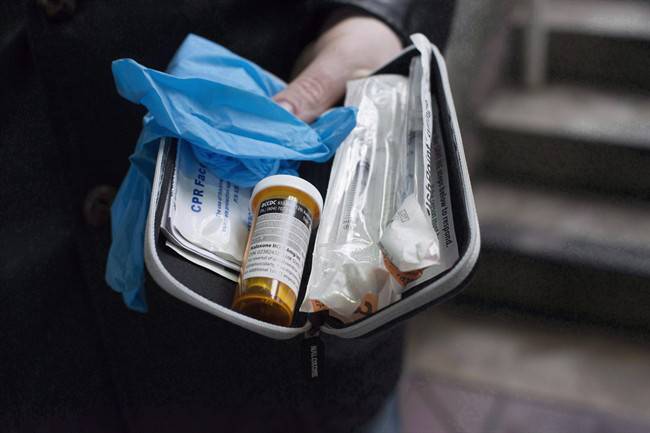Call it overdose reversal boot camp.

In the run-up to International Overdose Awareness Day on Aug. 31, Fraser Health will be using Facebook Live to conduct a real-time overdose response practice drill.
Anyone can tune in on Aug. 27 at 1 p.m. Pacific time, and public health officials will also be online to answer questions.
Fraser Health is also encouraging people and community organizations to use the week running to host their own drill.
It’s a part of the health authority’s bid to stem the mounting death toll associated with fentanyl-tainted street drugs. Nearly 3,000 people have died of illicit drug overdoses since B.C. declared a public health emergency in 2016.
The idea of the practice drill is to offer a demonstration on naloxone use, both to teach people who’ve never seen it, and as a refresher for those who have.
WATCH: B.C. Premier John Horgan on record 130 drug overdoses in one day

Naloxone, sometimes known as Narcan, is an injectible medication that functions to reverse an overdose.
“What it does is it reverses those effects of the opioid. Basically, it binds against those receptors so that the opioid doesn’t necessarily have that effect,” said Fraser Health Medical Health Officer Amir Bharmel.

Naloxone kits are free to anyone who is at risk of an overdose, or who is likely to encounter one — either through work, or friends and family.
Bharmal said more than 26,000 of the kits have been handed out in the Fraser Health region, and more than 114,000 province-wide. He said across B.C. they’ve been used to reverse as many as 25,000 overdoses.
But he said that while many people now have a kit, having the equipment is only one half of the equation.
“It’s more than just knowing how to use the kit, it’s knowing to call 911, knowing how to recognize an overdose very quickly,” he said.
That’s where the drills come in.
Fraser Health regional harm reduction coordinator Erin Gibson has trained thousands of people in how to use naloxone, and said that it’s easy to learn.
“It’s very easy, it’s just practice,” she said.
While virtually everyone who is given a naloxone kit gets a short training session with it, Gibson said it’s easy to miss the little details, or forget them later.
“While many people have gone out and got kits, they may not have had a chance to practice and they may not have ever used their kit, and so this is an opportunity to use their skills,” she said.
WATCH: New app teaches proper use of Naloxone

She said often people may not even recognize that they are witnessing an overdose.
“So people would be slow or no-breathing, they might be slightly blue, purplish or grey in colour, they may be making a snoring or gurgling rattling voice, and they would be unresponsive.”
Gibson said even if people are unable to participate in the online or one of the in-person community drills, they should make time to watch an instructional video online.
Gibson added that while having a naloxone kit and knowing what to do with it is a crucial part of the province’s overdose response, it is only a part of the answer — and that ending the stigma of drug use and building relationships with people struggling with addiction must also be a priority.
- Health task force blasted over ‘dangerous guidance’ for cancer screenings
- Dentists hesitant to sign up for federal dental plan; seniors advised to look at all options
- Preventing future pandemics goal of new U.S. partnership with 50 countries
- David Chang’s Momofuku to stop ‘chile crunch’ trademark battle after outcry
You can find out where to get a naloxone kit in B.C. here.
Steps to reverse an overdose using Naloxone:
- Recognize someone is overdosing
- Try to wake the person up: call their name, pinch them, rub your knuckles firmly on their upper chest
- Call 911
- Open the person’s airway by tilting their head back
- Administer mouth-to-mouth respiration, using a mask or barrier if you can
- If the person is still unresponsive, use naloxone — giving them one breath in between each step, or every five seconds
- Take one ampoule of naloxone from your kit
- Swirl ampoule to make sure all liquid is in the bottom
- Snap off the top of the ampoule
- Unwrap syringe, dip in nalxone, pull plunger to fill it up
- Push any air bubbles out of the syringe
- Push the needle into the subject’s thigh, buttocks or upper arm muscle
- Push down syringe plunger
- If the person remains unresponsive after three to five minutes, administer another dose of naloxone
With files from Lynda Aylesworth




Comments